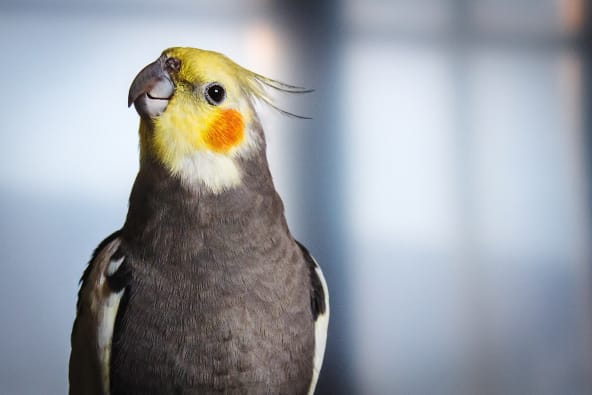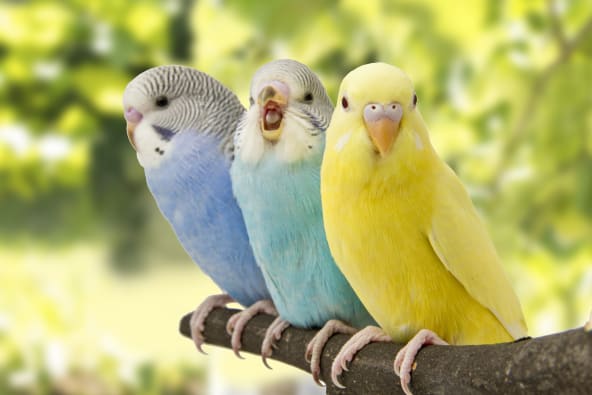When a pet bird uses its mouth on your hand, you may just be being "beaked" rather than bitten. Birds use their beaks much like they use feet, to grasp items and maintain balance; "beaking" is the correct term for this behavior. It's important to discriminate between beaking and biting so that you can provide the appropriate response when your pet bird gives you a true bite.
Why Birds "Beak" You
There are several reasons that a bird might beak you as opposed to giving you a true bite. First, pet birds routinely use their beaks as a third hand to test the strength of perches. They also use their beaks to generally check out the physical rigidity of all climbing structures, including its owner's hand before they step up. New bird owners often confuse this exploratory beak usage with being bitten.
Also, a bird's tongue contains myriad nerve endings, and it is used to sense taste and texture. If you are wearing new clothing or are holding new apparatus in hand, that beak may be aiding the tongue in evaluating those items that are new to the bird's world.
No matter the reason, while being beaked may not be the most pleasant experience, it feels quite different from an actual bite. Beaking feels more like the bird is using you as a stabilizing anchor point as it shifts posture and collects new information about its surroundings.

A True Bite
Birds will truly bite now and then, but only if they are frightened, startled, or if they feel cornered and vulnerable. Chances are that your bird is not trying to be aggressive, as biting is not a dominance behavior in birds. Biting among wild birds is usually only an act of self-defense, and not a "pecking order" signal, nor any type of punishment or social correction.
The true bite is often lightning-quick and hard. The bite is often accompanied by "ruffled feathers" body language which is meant to teach you to back away because the bird needs more space. However, many times this act of self-defense will break a handler's skin or at least result in a painful dent. This small injury is often the best way to tell the difference between being bitten and being beaked.
Responses to BeakingClick Here
One way you may inadvertently teach your bird to beak you more often is if you happen to let out a high pitched yell when you are beaked. This is especially true with younger birds that are still learning social norms1.
Birds, especially the parrots, are likely to interpret your sound as a positive comment and reinforcer; the bird will think you are praising it rather than protesting. In this way, socializing a bird is much like socializing a puppy. Use high vocal tones for approval and use low tones to discourage what is unwanted.
Once you have discerned which kind of beak use is occurring most often, it will be easier to alter both situations. Understands that beaking is just part of owning any bird. But if your bird's beaking is causing problems, the best option is to use a wrist perch, a leather arm cover, or a vest as an added layer of protection for your clothing and skin.
If you are in fact being bitten, a different response is required. There are steps you can take to help put your bird at ease and curb this undesirable behavior.
Correct Any True Biting
To correct bad behavior in birds, try not to get excited or call out vocally. Instead, use a frown and body language that shows you are unhappy. Speak calmly and softly in low tones to tell your bird that this is not acceptable behavior. As you do so, immediately place the bird back in its cage or on its perch.
Dealing with a pet bird that bites can be challenging, but with patience and consistent training, you can help address the behavior. Here are a few steps you can take:
1. Determine the cause: Observe your bird's behavior to identify any triggers or patterns that lead to biting. Birds may bite due to fear, territoriality, stress, hormonal changes, or discomfort.
2. Create a safe environment: Ensure your bird has a secure and comfortable living space. Provide appropriate toys, perches, and mental stimulation to prevent boredom or frustration, which can contribute to biting behavior.
3. Socialization and trust-building: Spend time bonding with your bird through positive reinforcement training and gentle handling. Offer treats, praise, and rewards when your bird displays calm and non-aggressive behavior. Gradually expose your bird to new people, objects, and experiences to help build trust and reduce fear.
4. Recognize warning signs: Birds often display signs of discomfort or aggression before biting, such as fluffed feathers, hissing, or lunging. Learn to recognize these warning signals and back off when your bird exhibits them to avoid triggering a bite.
5. Avoid reinforcing negative behavior: While it's important to address biting, avoid responding with aggressive or punitive actions, as this can escalate the issue. Instead, calmly remove yourself from the situation and withhold attention temporarily, signaling to your bird that biting leads to a loss of interaction.
6. Train with positive reinforcement: Use positive reinforcement techniques, such as clicker training or target training, to teach your bird desired behaviors. Reward your bird for stepping up onto your hand or following simple commands. Redirect your bird's attention to toys or activities when it shows signs of aggression.
7. Seek professional help if needed: If the biting behavior persists or becomes severe, consider consulting with an avian veterinarian or a professional bird behaviorist. They can provide specialized guidance and advice tailored to your specific situation.
Remember, every bird is unique, and it may take time and consistency to address biting behavior. Be patient, remain calm, and prioritize your bird's well-being by providing a nurturing and stimulating environment.



